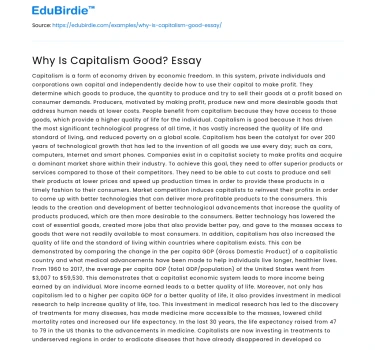Capitalism is a form of economy driven by economic freedom. In this system, private individuals and corporations own capital and independently decide how to use their capital to make profit. They determine which goods to produce, the quantity to produce and try to sell their goods at a profit based on consumer demands. Producers, motivated by making profit, produce new and more desirable goods that address human needs at lower costs. People benefit from capitalism because they have access to those goods, which provide a higher quality of life for the individual. Capitalism is good because it has driven the most significant technological progress of all time, it has vastly increased the quality of life and standard of living, and reduced poverty on a global scale.
Capitalism has been the catalyst for over 200 years of technological growth that has led to the invention of all goods we use every day; such as cars, computers, Internet and smart phones. Companies exist in a capitalist society to make profits and acquire a dominant market share within their industry. To achieve this goal, they need to offer superior products or services compared to those of their competitors. They need to be able to cut costs to produce and sell their products at lower prices and speed up production times in order to provide these products in a timely fashion to their consumers. Market competition induces capitalists to reinvest their profits in order to come up with better technologies that can deliver more profitable products to the consumers. This leads to the creation and development of better technological advancements that increase the quality of products produced, which are then more desirable to the consumers. Better technology has lowered the cost of essential goods, created more jobs that also provide better pay, and gave to the masses access to goods that were not readily available to most consumers.
Save your time!
We can take care of your essay
- Proper editing and formatting
- Free revision, title page, and bibliography
- Flexible prices and money-back guarantee
In addition, capitalism has also increased the quality of life and the standard of living within countries where capitalism exists. This can be demonstrated by comparing the change in the per capita GDP (Gross Domestic Product) of a capitalistic country and what medical advancements have been made to help individuals live longer, healthier lives. From 1960 to 2017, the average per capita GDP (total GDP/population) of the United States went from $3,007 to $59,530. This demonstrates that a capitalist economic system leads to more income being earned by an individual. More income earned leads to a better quality of life. Moreover, not only has capitalism led to a higher per capita GDP for a better quality of life, it also provides investment in medical research to help increase quality of life, too. This investment in medical research has led to the discovery of treatments for many diseases, has made medicine more accessible to the masses, lowered child mortality rates and increased our life expectancy. In the last 30 years, the life expectancy raised from 47 to 79 in the US thanks to the advancements in medicine. Capitalists are now investing in treatments to underserved regions in order to eradicate diseases that have already disappeared in developed countries. Novartis is an example of a corporation that is committed to expand access to healthcare in rural and underserved areas where millions of people are still affected with malaria and leprosy. This company has the mission to supply affordable medicines, create awareness and create new treatments to improve health in developing countries, such as India, Kenya and Vietnam. To summarize, capitalism has led to an increase in per capita GDP which helps drive a better quality of life by allowing individuals to afford more goods, and has increased medical advancements to help extend the life of an individual.
Finally, anti-capitalists sustain that the capitalistic greed for profit makes the rich richer and the poor poorest. However, there is data to show us a different story. In 1820, more than 90% of world population lived in extreme poverty. The percentage of the world population living in poverty decreased to 60% in 1970, 36% in 1990 and 10% in 2015. From 1990 to 2015 there was a decrease of 1.1 billion people living in extreme poverty. Capitalism helped lift the world out of poverty, thanks in part to the expansion of free market and economic development, which are two driving factors in a capitalistic system. No other economic system than capitalism has done a better job in fighting poverty. China is an example of how capitalism decreased poverty rates. In 1981 almost 90% of the population, 878 million of people, lived in extreme poverty. After the enactment of economic reforms and the adoption of capitalistic methods in the late 1970s, this number drastically decreased to 1.85% of the population living in poverty in 2013. Capitalistic reforms, which included the recognition of private rights to businesses, were a boost for private businesses that led to more profits. These profits allowed incomes to increase, which brought a vast reduction to the number of people living poverty. Today, China has become one of the most innovative countries in the world and a major consumption hub.
Conclusion
In conclusion, capitalism has brought to life new and innovative technologies that would not be possible without the freedom capitalism provides individuals and companies to operate under. Capitalism also helped eradicate some deadly diseases, which has helped increase the life expectancy of an individual, and has reduced the amount of people living in extreme poverty.
Lastly, capitalism has led to a better quality of life by providing a way for individuals to earn more money, buy cheaper goods, and expand their income’s purchase power. Overall, capitalism is good because it has improved life for a majority of individuals in this world.






 Stuck on your essay?
Stuck on your essay?

